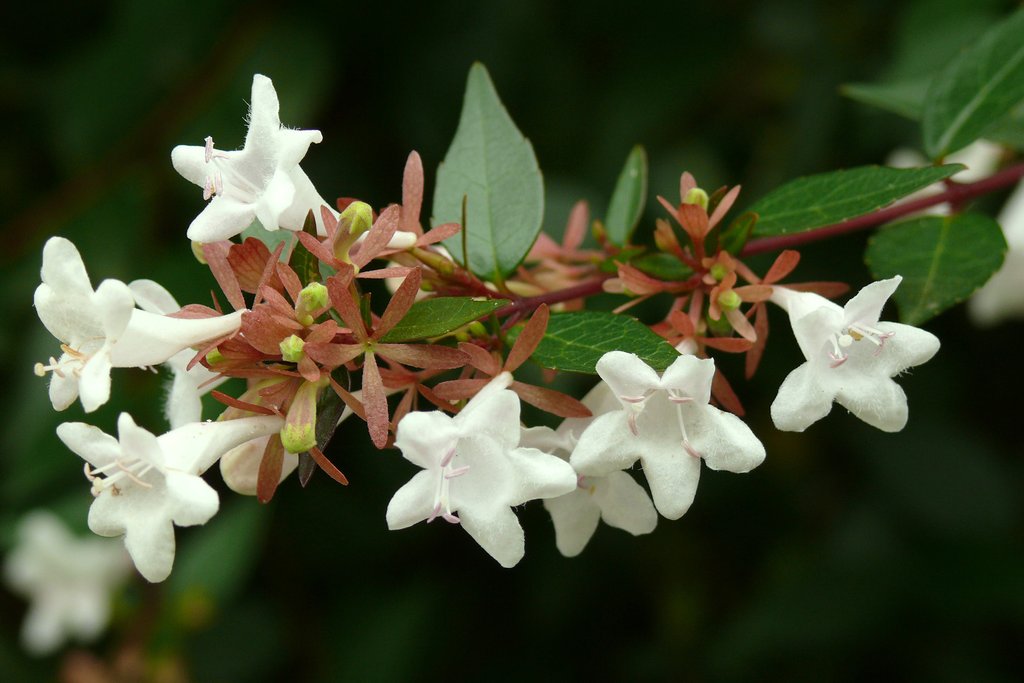Growing Abelia

With today’s busy lifestyles, homeowners are always looking for ways to liven up their landscapes without a lot of effort. Abelia is an ornamental shrub that is under-appreciated and underused in many parts of the country and is worth a second look. Grown for its attractive foliage and exceptionally long bloom time, it is virtually maintenance-free once established. The eye-catching leaves come in many different colors—from gold to burgundy—that often change throughout the growing season. Fragrant tubular flowers bloom for months, making it a nonstop food source for hummingbirds, butterflies and insect pollinators.
Related to honeysuckle, the genus Abelia includes 30 species of deciduous and evergreen shrubs that are native to Eastern Asia and Mexico. Glossy abelia (A. xgrandiflora), the most common garden species, produces shiny semi-evergreen leaves in colder zones, while retaining year-round color in warmer regions. Newer hybrids are bred for unique foliage color, showier flowers and compact sizes more suitable to small urban lots.
Zones: 4 to 11, varies by type
Height/Spread: Upright arching habit, 2 to 10 feet tall and 2 to 8 feet wide
Exposure: Full sun to partial shade; foliage color and bloom are best in full sun.
Bloom time: Spring to fall
Color and characteristics: Oval, pointed leaves up to two inches long are produced on graceful, arching branches. Foliage is glossy green or yellow, with hints of rose, orange, bronze or burgundy. Some are variegated or multi-colored. Many varieties have leaves that change color as the seasons progress. Tubular flowers with four or five petals form in clusters on the tips of the stems. The small flowers, which are usually fragrant, come in shades of white, pink and yellow. Other attributes include colored sepals and stems, fall color and exfoliating bark.
Toxicity: Abelia is not known to be toxic to children or pets, and is sometimes used as hedging for pastures.
Planting
When to plant abelia
- Plant during milder months of spring or fall to avoid heat or cold stress.
Where to plant abelia
- Choose a sunny to lightly shaded site with fertile, well-draining soil that will stay evenly moist.
How to plant abelia
- Loosen soil in the planting area and amend with compost. Remove plant from container and gently tease out roots or slice the root ball in several places if potbound. Dig a hole slightly deeper than the root ball and twice as wide. Place the plant in the hole so the top of the root ball is slightly above ground level. Fill in the hole, tamp down soil around the base and water well. Spacing depends on the variety.
How to choose the right abelia
With different sizes and forms to choose from, here are some tips to consider:
For borders and landscapes: Choose varieties that will fit the scale of your landscape. Use as hedging, screening, in a mixed border, as foundation plantings or a stand-alone focal point. Make sure to allow room for plants to mature without becoming crowded.
For slopes and hillsides: Select varieties suitable to the size of your property and mass along a slope or hillside for erosion control.
For containers: Dwarf types will stay small and not overwhelm a space. Use as a stand-alone focal point in a container, or group with other containerized plants for maximum visual impact.
Care
How to prune abelia
- Abelia looks best when allowed to retain its natural shape and size. Since glossy abelia (A. xgrandiflora) blooms on new wood, prune in late winter to early spring before new growth emerges so that flowers are not sacrificed. Remove any dead or damaged branches, and thin as needed to encourage new shoots. Lightly prune to shape. Some varieties produce long, errant watershoots (thin shoots that grow out of the trunk or branches); cut those out whenever they appear. To reinvigorate your abelia, thin out up to a third of the branches every few years. Deciduous varieties that bloom on old wood (such as A. mosanensis) should be pruned lightly as needed just after flowering.
Watering:
Though drought and heat tolerant once established, it performs best with regular watering. Irrigate once or twice a week during summer.
Soil:
Abelia prefers slightly acidic, organically rich soil that’s kept moderately moist and drains well, but is tolerant of a variety of conditions.
Amendments & fertilizer:
Apply a slow-release fertilizer formulated for woody plants in early spring. Mulch around the root zone with organic matter to retain moisture and suppress weeds.
Deer resistance:
Deer will leave it alone for the most part, though extreme conditions can result in deer grazing on plants they wouldn’t otherwise.
Pests/Diseases
- When planted in optimal conditions, abelia exhibits few, if any problems. Possible diseases include powdery mildew and anthracnose. Pests include aphids.
Website: www.gardendesign.com